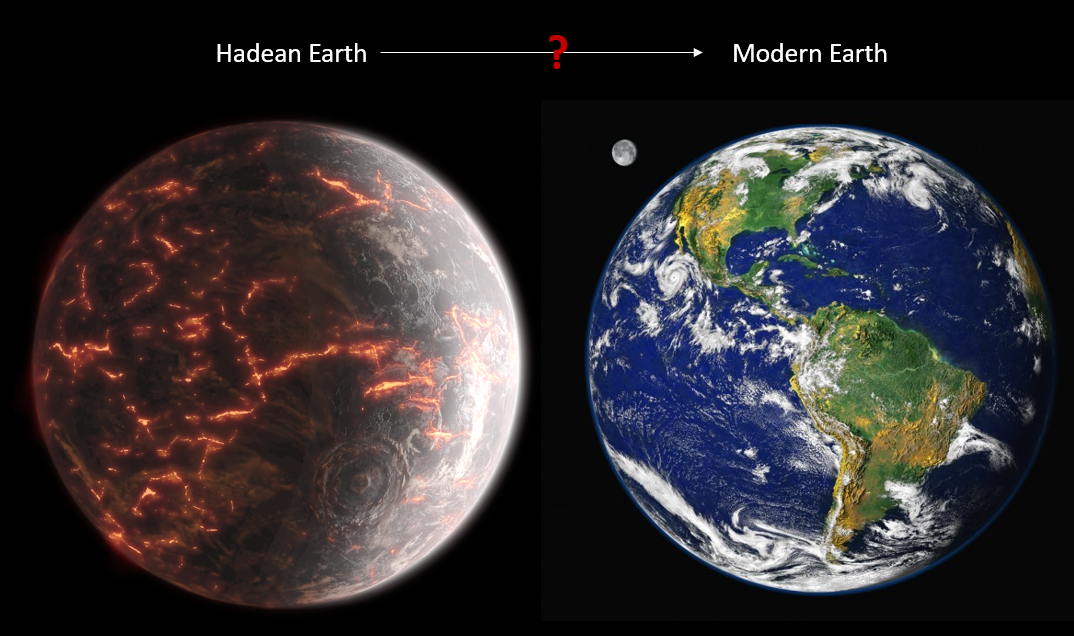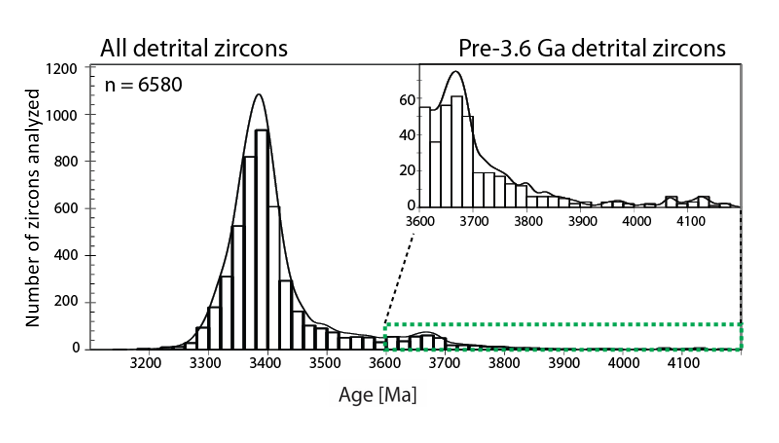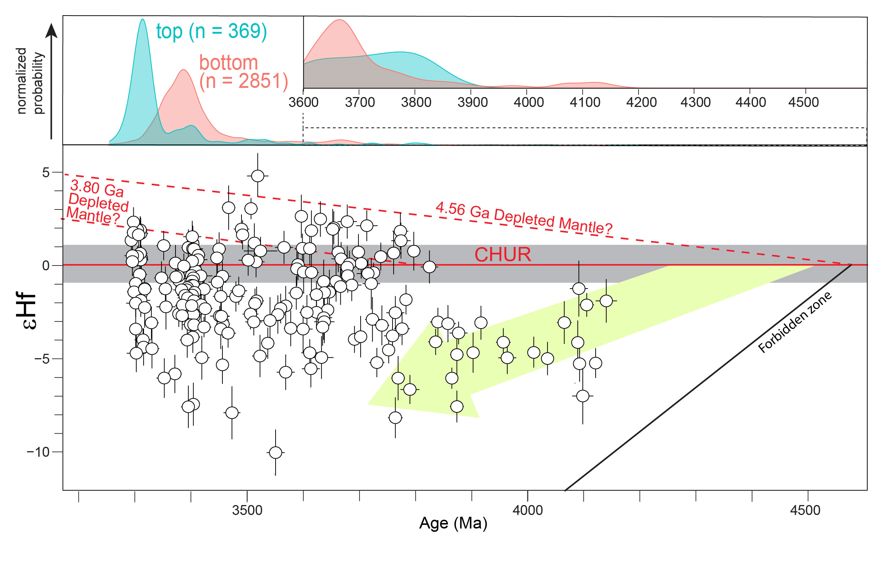Nadja Drabon on a New Lens Into the Hadean Eon
Listen to the podcast here, or wherever you get your podcasts.
Nadja Drabon’s research aims to unravel the processes that formed the Earth’s earliest crust. She does this by studying extremely ancient zircons. These are few and far between, so the discovery of a new source of such zircons in the Barberton Greenstone Belt of South Africa was exciting to early Earth researchers. In the podcast, she describes how she and her team used these zircons to discern a significant change in crustal processes about 3.8 billion years ago when much more fresh crust began to form.
Nadja Drabon is Assistant Professor of Earth and Planetary Sciences at Harvard University.
Podcast Illustrations
Images courtesy of Nadja Drabon unless otherwise indicated.
Geological timeline showing the division of the Precambrian into the Hadean, Archean, and Proterozoic eons. In the podcast, Nadja Drabon discusses zircon crystals that were formed in the Hadean or early Archean. The zircons are detrital, their parent rocks having disappeared.
Courtesy of BGS and UKRI
The Hadean Earth is thought to have been covered by an ocean of magma before it started forming its first solid crust. Early Earth researchers aim to discover what the Earth was like following the formation of the first crust and before the modern Earth developed, with its thick continents and thin, subducting seafloor.
Courtesy of Alec Brenner and NASA Earth Observatory
Hadean zircon locations. The vast majority known to date have been found in the Jack Hills in Western Australia. Nadja Drabon and her colleagues discovered Hadean zircons in the Green Sandstone Belt of the Barberton Greenstone Belt (BGB) in South Africa. This provides us with an opportunity to test how representative the Jack Hills zircons are of the Hadean Earth.
The Green Sandstone Bed
Comparison between the Green Sandstone Bed (GSB) and the Jack Hills. The ages given above are for the ages of the host sandstones that contain the Hadean zircons. The GSB is better preserved than the Jack Hills since it has been subject to less extreme metamorphism (greenschist vs. amphibolite facies). Furthermore, the GSB was silicified early in its history, enabling structures down to micron scale to be preserved., which allows for studies of the rock’s microstructure.
Jack Hills photo courtesy of Bruce Watson
Field location of the Green Sandstone Belt, where the rocks appear in scattered outcrops.
Age distribution of the detrital zircons found in the Green Sandstone Bed. The inset shows the age distribution of the zircons older than 3.6 billion years (Ga). Only 0.5% of the zircons are Hadean, i.e., have ages greater than 4 Ga. This contrasts with the Jack Hills, where 3-12% of the zircons are Hadean.
Photomicrographs of ancient zircons using cathodoluminescense to reveal various domains formed during different phases of the zircon’s history. Since each domain may have a different age and different isotope and trace-element composition, it is crucial to position the laser beam that ablates the particles for the U-Pb dating in precisely the same location as the laser beam generating the particles for the trace-element and isotope abundance measurements. This “registration” problem was overcome by the split-stream laser-ablation method described by John Cottle in the previous podcast episode. As she explains in the podcast, Nadja Drabon did not use the split-stream method as it would not have provided sufficient mass-spectrum resolution to distinguish the trace elements and rare-earth elements that she analyzed.
Hafnium Isotope Analysis
Using Hafnium to probe crust-mantle differentiation
The method is based on the beta decay of 176 lutetium to 176 hafnium, which has a half life of 37 Ga. The graph plots a measure of the ratio of hafnium 176 to hafnium 177 (which is constant) relative to the chondritic uniform reservoir (CHUR) over time. CHUR is the mean chemical composition of the part of the Solar Nebula from which the Earth formed. Since lutetium preferentially stays in the mantle as compared to hafnium, the rate of hafnium 176 production is greater in the mantle than in the crust. This is shown by the upward sloping line for depleted mantle (DM, i.e., the mantle after removal of crustal material). Juvenile crust is freshly formed from the mantle, and thus contains the Hf ratio similar to that of the mantle and plots closer to the line labeled DM. Rocks formed out of old crust (blue dots) reflect the signature of the mantle when it was originally extracted, with only a slight increase from decay of the small amount of 176 Lu that enters the crust.
Results of the hafnium isotope analysis for the GSB zircons. Before about 3.8 Ga, most of the zircons plot well below the CHUR line, suggesting that they formed out of old crust. These zircons fall on a range of eHf vs. time, which suggests that it was the same old crust that was extracted in the Hadean and subsequently repeatedly melted and recrystallized. After 3.8 Ga, the distribution of zircons spans a larger range of 176Hf/177Hf, including values that lie above the green arrow and the CHUR line, suggesting that they formed out of magmas generated from mixed juvenile and old crust. The plot above the hafnium graph shows the age distributions of zircons found in the bottom and top layers of the Green Sandstone Bed. The inset is a detailed enlargement of the older zircon populations.
In the podcast, Nadja Drabon describes a possible process by which Hadean and Archean crust might be exposed to and interact with fluids before the onset of modern plate tectonics. The diagram compares the subduction zone of modern plate tectonics with a theorized “sagduction” of a hot crust in the Hadean and early Archean.
Stern, R.J. (2013), GSA Geoscience Blog
Trace and Rare Earth Elements Analysis
Nadja Drabon and her colleagues measured the abundances of certain trace elements within the ancient zircons of the GSB. By plotting various ratios of these trace elements on graphs, it is possible to compare the distribution of the GSB zircons with those of zircons known to have formed in one of the modern settings in which magma is generated and then cools to form igneous rocks (tectono-magmatic settings). The colored fields represent a global compilation of zircons from different Phanerozoic (i.e., post 539 Ma) tectono-magmatic settings. The dots on the graphs are color-coded by age and reveal that the zircons older than 3.8 Ga overlap with relatively undepleted mantle, but that zircons younger than 3.8 Ga overlap with volcanic arc settings as well as undepleted mantle. Since modern volcanic arcs are characterized by melting in the presence of water, this suggests that water, maybe even an ocean, was present after 3.8 Ga.
Grimes, C.B. et al. (2015), Contributions to Mineralogy and Petrology, 170(5), 1
Oxygen Isotope Analysis
In the third type of zircon analysis described in the podcast, Nadja Drabon measured the abundance of oxygen isotopes. The ratio of 18O to 16O in a zircon is a sensitive temperature-dependent tracer of fluid and solid interactions in the crust. This ratio is determined by the thermodynamic equilibrium between the melt out of which the zircon formed and the material around it. Zircons with low values of 18O to 16O are consistent with melts derived from the mantle. Zircons that formed in melts that formed from or assimilated crust altered at low-temperature show higher values (> 6.5 ‰), and zircons that assimilated crust altered at high temperature show lower values than the mantle.
VSMOW = Vienna Standard Mean Ocean Water, which is an isotopic standard for pure water with no salt or other chemicals found in the oceans. It is the water molecules that are taken from the ocean. The delta notation (symbol: δ) expresses the variation of the isotopic ratio of 18O/16O) relative to the isotopic ratio of VSMOW.
Roberts, N.M.W. et al. (2014), Continent Formation Through Time, Geol. Soc. London Special Pub., 389
Oxygen isotope results for the Green Sandstone Bed
The GSB contains zircons that show elevated δ18O values in the Hadean, which supports the notion that a hydrosphere was present even at that very early time.
The plot above the oxygen isotope graph shows the age distributions of zircons found in the bottom and top layers of the Green Sandstone Bed. The inset is a detailed enlargement of the older zircon populations.
Global Hafnium Isotope Analysis
Plots of hafnium isotope ratios in zircons taken from Archean rocks in various parts of the world with the GSB zircons superposed (black dots). As described for the hafnium isotope plots above, zircons older than 3.8 Ga predominantly plot below CHUR and over a broad range, suggesting reworking of older crust. New crustal additions, which plot above the arrows, only became common after 3.8 Ga. The results are broadly consistent with a global change between 3.8 and 3.6 Ga, when the Earth’s outer layer may have transitioned from a stagnant old crust (stagnant lid) to mobile lid tectonics.
Bauer, A. et al. (2020), Geochem. Perspect. Lett. 14, 1-6
Further Reading
Drabon, N., et al. (2021), PNAS, 118 No. 8 e2004370118
Drabon, N., et al. (2022), AGU Advances, 3, e2021AV000520
Stern, A. (2013), Speaking of Geoscience, GSA Guest Blog















